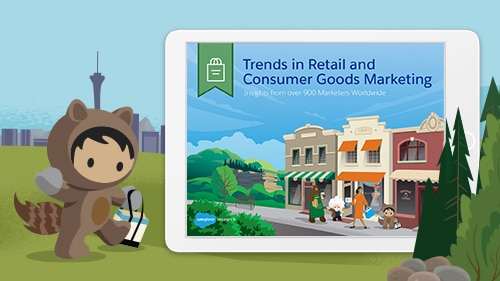Shopping has ceased to be defined by the boundaries of brick-and-mortar. Consumers expect brands to meet them wherever they are, offering an experience tailored to their individual needs across the entire shopping journey. Retail and consumer goods marketers are on the front lines of creating those memorable, not purely transactional, experiences.
Today at Shoptalk, Salesforce released “Trends in Retail and Consumer Goods Marketing,” sharing the biggest trends in retail and consumer goods marketing in 2019. Based on a survey of nearly 900 retail and consumer goods marketers worldwide, here’s an overview of our top four findings.
1. Marketing is the glue of customer experience
You’ve heard it for a while now, but in a race to the bottom driven by promo codes and free shipping, retail and consumer goods companies must compete on experience. Marketing departments are increasingly responsible for driving innovation in customer experience, according to our research. In fact, 40% of retail and consumer goods marketers are leading customer experience initiatives. This is up from 24% in 2017.
In a rising number of organizations, marketing is the department bringing together cross-functional teams to deliver the seamless and personalized experiences shoppers demand across touchpoints. More than half (51%) of retail and consumer goods marketers are actively mapping the customer journey across the company from when customers first see an ad to when they place an order to when they return for service. The majority of retail and consumer goods marketers share common goals and metrics with their companies’ advertising and service teams (62% and 53%, respectively). Slightly fewer (51%) do so with their commerce counterparts.

2. Retail and consumer goods marketers struggle to balance personalization and privacy
AI can predict which products shoppers will want and deliver personalized interactions. This drives major revenue — for example, during the 2018 holiday season, AI-powered recommendations yielded 14% higher average order value. Retail and consumer goods companies are taking note. Our study found that, while only 25% of retail and consumer goods marketers are leveraging some form of artificial intelligence today, that figure is projected to grow to 70% over the next two years (a 176% increase).
While AI and data are critical for meeting shoppers’ elevated expectations, data privacy and customer trust must also be top of mind. Eighty percent of retail and consumer goods marketers say balancing privacy and personalization is a priority, yet only 28% of them are completely satisfied with their ability to do this. For marketers to truly reap the benefits of data, clear privacy policies are tantamount. The lesson? You can’t have a truly engaging, sustainable relationship with your customers without trust.

3. Real-time engagement is a goal, not a reality, for most marketers
We’ve heard marketers talk about engaging customers in real time for years. Yet today, very few marketers are actually able to communicate a unique message to customers based on their last action or engagement with a brand.
Over one-quarter (27%) of retail and consumer goods marketers describe their channel coordination as generally siloed, and 33% describe it as dynamically coordinated — when messages evolve across channels based on customer actions. The rest (40%) say their customer-facing channels feature duplicate messaging — identical messages broadcast across channels.
In an omni-channel world, the gold standard is dynamic, not duplicate, conversations between customers and brands. Channels with the highest rates of duplicate messaging are banner ads, social advertising, and mobile apps (42%, 41%, and 41%, respectively).

Modern marketing requires sensitivity to context about where, when, and how consumers are interacting with your brand. For example, a push notification right outside a store should be different than the notification a customer gets at home, even if it’s for the same product. In the move from mass marketing to personalization, marketers are making progress in creating content across channels consistently — but most (67%) are still not personalizing messages in a truly contextual way.
To make that contextual conversation more complex, retail and consumer goods leaders manage a long and growing list of marketing channels. The average retail and consumer goods marketer uses eight channels, and expects to use 13 next year. Voice technology is especially poised for growth over the next 12 months, with a projected growth rate of 127%, bested only by VR and AR at 218%.

4. Data unification is now a top priority at retail and consumer goods companies
Shoppers have ample choice of where to fill their carts: marketplaces, brick-and-mortar stores, digitally native pureplay brands. Their preferences can be a moving target, so marketers are turning to more data sources than ever to understand customers’ unique wants and how to retain their loyalty over time. The problem is that marketers struggle to unify all that data. The number of data sources that retail and consumer goods marketers use grew to 16 in 2018, up from 10 in 2017 (a 60% increase).

With so many data sources, less than half (49%) of retail and consumer goods marketers report having a completely unified view of customer data sources. Clean and normalized consumer data — across the growing number of sources — is a critical foundation for personalized engagement. And data management platforms (DMPs) are an increasingly popular tool for unifying customer identity across disparate data sources: 55% of retail and consumer goods marketers use a DMP today.
The retail renaissance is in full swing, and this research shows that retail and consumer goods marketers are up for the challenge. Read more findings in the full report, and connect with us this week at Shoptalk to learn more about Salesforce for retail.





























